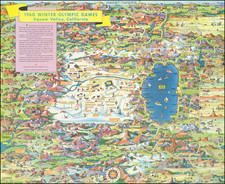Early Surveyor General certified copy of Henry Hancock's original survey of Antonio Maria Lugo's Rancho San Antonio, in Los Angeles County, California.
The map is relatively sparse, but shows the Mission San Gabriel, Fort Hill, a Church, the home of Jose Del Carmen Lugo, the home of Vicente Lugo, the home of the Widow Chino Lugo, what appears to be a Lake named "Cienega," a place identified as "Segundio Valenzuela, the home of Jose Antonio Lugo, Manuel Dominguez's home, and several lakes and river. One of these structures is likely what would become the Henry Gage Mansion, constructed by future Governor Henry T. Gage following his marriage to one of the Lugo heirs, Francis "Fanny" Rains, in 1880.
Rancho San Antonio was originally granted to Corporal Antonio Maria Lugo, after seventeen years of military service, in 1810. The grant was confirmed in 1838 to Antonio Maria Lugo by Mexican Governor Juan B. Alvarado.
With the cession of California to the United States following the Mexican-American War, the 1848 Treaty of Guadalupe Hidalgo provided that the land grants would be honored. As required by the Land Act of 1851, a claim was filed with the Public Land Commission in 1852, and the grant was patented to Antonio Lugo in 1866.
In 1855 Antonio Maria Lugo, partitioned the Rancho-reserving a homestead for himself-among his sons, José Maria, Felipe, Jose del Carmen, Vicente and José Antonio, and his daughters, Vicenta Perez, Maria Antonia Yorba, and Merced Foster. In 1860 Merced Foster and Vicente Lugo sold their respective portions to Los Angeles developers who subdivied the land for sale in small lots. The first deed is from Isaac Heiman to David Ward, dated June 21, 1865; followed by other sales in 1865 and 1866.
Henry Hancock was a Harvard trained lawyer and a land surveyor working in California in the 1850s. He was the owner of Rancho La Brea, which included the La Brea Tar Pits.
Hancock studied law at Harvard University. Graduating in 1846, he went St. Louis, Missouri, where he became a surveyor. During the Mexican–American War, he was quartermaster of the 1st Regiment Missouri Mounted Volunteers under Colonel Alexander William Doniphan. At the war's end, he returned home to New Hampshire but soon decided to go west.
Hancock travelled from Chicago to San Francisco, arriving in September, 1849, where he opened a law office. He briefly tried gold mining on American River, but in 1850 moved to Los Angeles.
Hancock engaged extensively in government surveying. Following California's annexation into the United States, the land grants given to Californios by the Spanish and Mexican colonial authorities were required to prove their claims to the new American government. Owners filed claims with the United States Land Commission and had to have their property surveyed and mapped by government surveyors.
Hancock was among the first and most prominent surveyors in Southern California. He served as Deputy Surveyor for the United States, but is better known for his work representing private claimants. He surveyed Rancho San Pedro for the Dominguez family, Rancho San Francisco for the Del Valles, Rancho San Jose owned by the Palomares and Vejar families; and Henry Dalton's Rancho Azusa de Dalton.
Hancock also served as the city surveyor for Los Angeles. He was first employed to do survey work for the city in 1853 to 1854.
On February 5, 1856, the United States Land Commission confirmed four square leagues of land to the City of Los Angeles (using 2.63 miles per league) with the center of the Plaza designated as the center of city land. As United States Deputy Surveyor, Hancock, surveyed the lands confirmed to the City by the United States Land Commission Patent of 1856.
In 1854, Hancock, along with Benjamin Davis Wilson, bought Rancho Rodeo de las Aguas. Hancock was elected to the California State Assembly as a Democrat, representing the 1st District from 1858 to 1860.
As a lawyer, Henry Hancock worked for the Rocha family to aid them with their efforts to prove their claim to Rancho La Brea. The Rochas finally won their claim, but like so many other Californios, their legal expenses left them broke. In 1860 Jose Jorge Rocha, the son of Don Antonio Jose Rocha, deeded Rancho La Brea to Henry Hancock.
During the American Civil War (1861–1865), when there was considerable Confederate sympathy in Southern California, Hancock sided with the Union. He became major of the 4th California Infantry Regiment and for a time was commanding officer of Camp Drum, established to guard against pro-Confederate activities near Los Angeles. He also was sent to Santa Catalina Island to survey it and chose the location for its Union garrison.
After the war, Hancock engaged in the commercial development of the asphaltum deposits on Rancho La Brea. He promoted its use for sidewalk and paving purposes, and shipped considerable quantities to San Francisco by schooner.
In 1863 Hancock married Ida Haraszthy (Ida Hancock Ross), the daughter of Agoston Haraszthy, the "Father of Modern Viticulture in California".









![(Humboldt Atlas and Text) Geographique et Physique du Royaume de Nouvelle-Espagne [with quarto text:] Essai Politique de la Royaume de la Nouvelle-Espagne](https://storage.googleapis.com/raremaps/img/small/99796.jpg)
![Parts of E. California and S. E. Nevada, N.W. Arizona and S.W. Utah __ Atlas Sheet No. 66 [Shows Las Vegas!]](https://storage.googleapis.com/raremaps/img/small/92030.jpg)
![[Oregon / Mount Hood / Columbia River to Bodega Bay] Cote Nord-Ouest De L'Amerique Reconnue par Cape. Vancouver 2e. Partie . . .](https://storage.googleapis.com/raremaps/img/small/82223.jpg)


